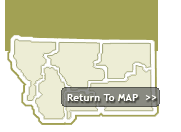

| Home | Communities | Accommodations | Places To Go | Things To Do | Site Map |
|
Glacier Country
Central Montana
Missouri River Country
Southwest Montana
Yellowstone Country
Southeast Montana
|

Rattlesnake Recreation Area and WildernessMissoula MontanaListing Type: Wilderness AreaCity: Missoula Montana Region: Glacier Country 406-329-3814 http://www.fs.fed.us/r1/lolo/ |  More Images |
With the major trailhead only 4.5 miles north of Missoula, the 61,000 acres of glaciated topography in the Rattlesnake Wilderness and National Recreation Area (RWNRA) form Montana's premier urban wilderness, blending the best of both wilderness and civilization. The U-shaped Rattlesnake basin is fed by more than fifty small creeks that begin as seeps from springs and melting snowbanks in the upper Wilderness portion of the NRA. Resting in the more than thirty high mountain lakes, crystal clear water then plunges down waterfalls to hanging valleys separated by sheer headwalls and carpets of sub-alpine fir, lodgepole pine, and spruce sloping down to open Douglas fir and ponderosa pine parklands.
The non-wilderness (yet still wild) part of the NRA , devoted to wildlife and recreations, is guarded by the southern flanks of Stuart Peak. From this prominent point north a knife edge ridge climbs still higher to the sentinel of the Rattlesnake-remote 8620-foot McLeod Peak. The east side of the ridge is marked by cliffs, cirques, and rolling basins of intermittent subalpine forest where transplanted mountain goats are thriving in the security of protected wildlands. The gentler western slopes lead down to the open bowl-like basin of upper Grant Creek. Although uncommon, occasional grizzly bears roam here, and every so often the haunting howl of a lone wolf deepens the feeling of wildness.
The adjacent wildlands north of McLeod Peak and the rugged Rattlesnake Divide were once vision-quest sites for the Salish Indians. Today, the Flathead Indian Reservation protects this sacred land which is open to tribal members only
.Day use is by far the dominant form of recreation, largely due to a rapid increase in use by joggers and mountain bikers up both the main Rattlesnake Creek and Spring Gulch. Hunting and fishing are the traditional uses of the Rattlesnake Wilderness. The main Rattlesnake Creek is open to catch-and-release fishing above the mouth of Beeskove Creek. Many of the high lakes are periodically stocked. When snow conditions permit, the main Rattlesnake and side drainages are readily accessible to cross-country skiers.
There is a well established trail system in the Rattlesnake lower half affording opportunities for day trips or you may choose to travel further into the wilderness for overnight camping. Camping is allowed beyond the 3-mile radius from the Rattlesnake's main trail head. But remember no motorized vehicles or bicycles are allowed within the wilderness boundary. The maximum party size is ten people along with a maximum of ten head of pack or saddle stock per party. For more details ask for the Rattlesnake and Sawmill/Curry Brochures or the Missoula Trails brochure.
Directions: Take the Van Buran Street Exit off I-90 on the east end of Missoula and go 4.5 miles north on Rattlesnake Drive to the main parking area and jumping-off point on the west side of Rattlesnake Creek. The road takes off up the old Rattlesnake FR 99, now closed to all motorized recreational travel. The main trailhead has handicapped access toilets and another one 1.5 miles up the main corridor. The area is closed to dogs in the winter to protect elk on their winter range and during calving season. In the summer dogs are allowed only on leashes before the 1.7 mile mark. If you're visiting the Rattlesnake on horseback, park at the recently completed trailhead for equestrians on the east side of the Rattlesnake Creek. The new horse trails to a horses-only bridge across the Rattlesnake just above the Stuart Peak/Spring Gulch trail.
Rattlesnake Recreation Area and Wilderness
Lolo National Forest, Missoula, MT 59804
|
A source for Montana Travel & Tourism Information
![]()